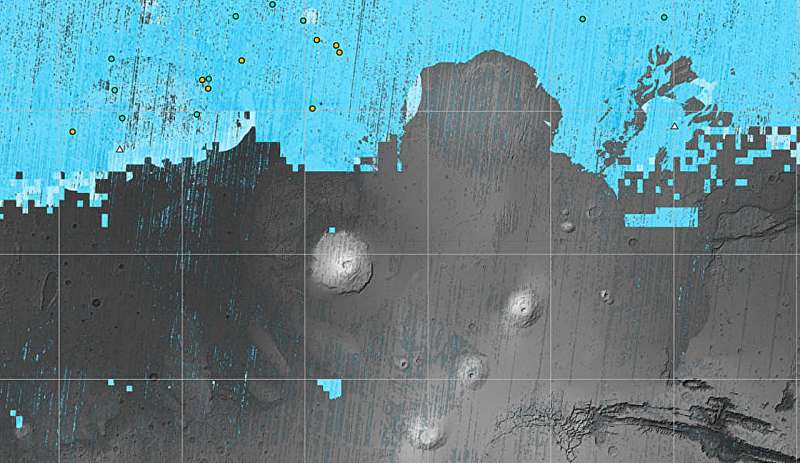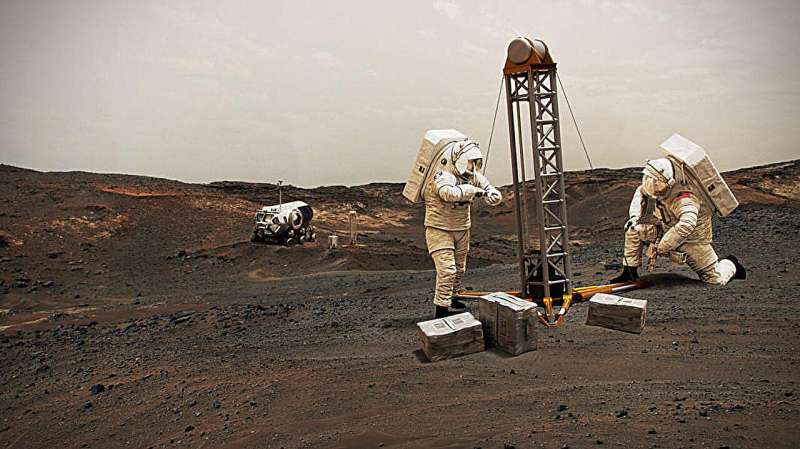This article has been reviewed according to Science X's editorial process and policies. Editors have highlighted the following attributes while ensuring the content's credibility:
fact-checked
trusted source
proofread
New mapping tools will find subsurface water ice on Mars

Refined mapping tools that identify subsurface water ice on Mars will help determine the best targets for robotic and human missions to the planet.
The fourth phase of NASA's Mars Subsurface Water Ice Mapping (SWIM) project has generated three maps that show ice in depths of zero to one meter, one to five meters and deeper than five meters, said Gareth Morgan, SWIM Co-Principal Investigator and Senior Scientist at the Planetary Science Institute. The project used for the first time data from HiRISE—the High Resolution Imaging Science Experiment camera onboard the Mars Reconnaissance Orbiter.
"We have refined the mapping techniques employed by the Mars SWIM project to improve our understanding of the distribution of subsurface ice. In particular, we have further constrained the boundary between where ice is present and where it is absent within the northern hemisphere," Morgan said.
"Our efforts provide a new tool to help future Mars mission operations prioritize target acquisition. In particular, a major focus of this work has been to support a future synthetic-aperture radar (SAR) ice mapping mission such as the proposed International Mars Ice Mapper (I-MIM) concept."
"Our maps are also important for future landed missions, both robotic and human. Mission planners looking to study shallow ice can use our maps as part of their landing site sections," said Nathaniel Putzig, the other SWIM Co-Principal Investigator.
"In the case of human landing sites, planners will want to identify regions that have adequate ice for resource extraction to enable life support and fuel generation, as well as to identify scientifically interesting terrains. With our maps being released publicly, the community can use them to refine landing site studies."

"Of course, safely delivering humans to Mars and ensuring their survival requires many other considerations beyond in situ utilization of water-ice resources, including landing-site safety and solar and thermal specifications. Defining such site requirements is beyond the scope of the SWIM project and would be premature, given that all human Mars mission plans are still in the conceptual stage," Morgan said. "We provide a hemispheric perspective of ice distribution to support initial landing-site studies and enable the community to explore the range of Martian terrains that host ice."
"In the harsh environment of the Martian surface, ice can act as a radiation shield. Biosignatures of past life in many ways are more susceptible to ionizing radiation damage than actual living organisms. So ice could preserve signatures of ancient life," Morgan said. "Also if you can melt ice you have water of course, which is believed to be essential to life. So, in the very big picture, our maps will be of interest to exobiology studies."
HiRISE has also revealed so-called "polygon terrain," where the seasonal expansion and contraction of subsurface ice causes the ground to form polygonal cracks. Seeing these polygons extending around fresh impact craters that have revealed ice is yet another indication that there's more ice hidden beneath the surface at these locations.
Provided by Planetary Science Institute




















